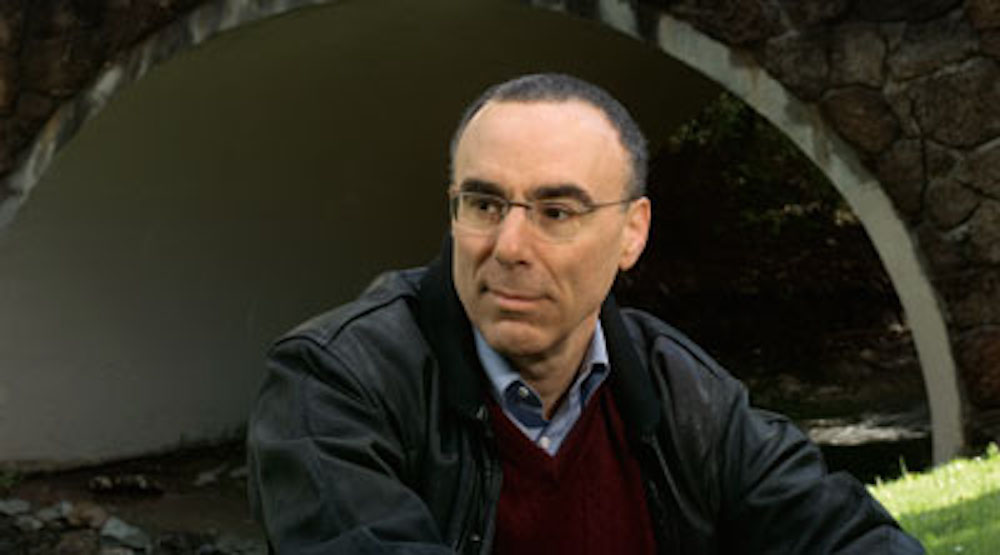
Robert Sharf is the Chair of the Berkeley Center for Buddhist Studies and a professor in the Department of East Asian Languages and Cultures. His research focuses mainly on medieval Chinese Buddhism but also includes Japanese Buddhism, Buddhist modernism, ritual studies, and Asian philosophy. Interview by Mariana Escobar and Ava Inman.
Mariana Escobar: Hi, I’m Mariana. I’m the one who took your class!
Ava Inman: Hi, I’m Ava. Nice to meet you.
Mariana Escobar: To start, so we have context: if you could describe the way traditional Buddhism—we could stick with Theravada, for example—views life. If someone didn’t know anything about the four truths or the eightfold path, how would you explain the Buddhist mindset simply? Just so we have some context for people who don’t know anything about Buddhism.
Ava Inman: Me. I don’t know anything, really.
Robert Sharf: In Early Buddhism, people will always start with the four noble truths. That’s the traditional way to do it. You start with the fact that life is suffering. Buddhists see suffering as an existential truth. All sentient beings suffer. And the second noble truth is that there’s a reason that they suffer, and it’s because people want the world to be other than it is. So they desire things, and they hold on to things. And the third noble truth is that it is possible to exist without desire, and that mitigates suffering. The fourth noble truth tells you howto do that: the eightfold path. Those are the standard Buddhist beliefs.
Ava Inman: What are key Buddhist principles that can be applied to economic thinking? Are there any specific Buddhist teachings about economics, or does it mostly revolve around nonattachment?
Robert Sharf: Well, I think Buddhism would have a lot to say about how people involved in business economics could act to mitigate human suffering. There’s a saying: “You can’t preach the dharma to an empty stomach.” The dharma is the teachings of the Buddha. In other words, if people don’t have basic needs met, if they’re hungry or homeless, there’s no point in bringing them Buddhist teachings. Basic human needs have to be provided for first; beyond that, it will not necessarily bring more happiness. Buddhism always bears relevance when talking about human welfare and happiness. It’s not necessarily going to tell you ways to improve profitability or efficiency, but it can remind you that making more money may not make your staff happier. If you want a happy workplace, you might consider a Buddhist analysis of human psychology.
Ava Inman: There’s welfare economics, which is similar in ways. It’s an interesting field of study.
Robert Sharf: In Buddhism, it’s commonplace to say that money doesn’t equate happiness. Unfortunately, people refer to it as just kind of an empty refrain, and its ubiquity has made it a little meaningless. The Buddhists, however, would engage by offering a precise explanation of why that is. Why, and how, can the introduction of money make things worse?
Mariana Escobar: That’s a nice transition into another question, regarding any advice you have for economists. There’s an emerging school of economics that encourages a more humanistic mentality to economics, prioritizing the human condition and happiness. Do you think economics should be approached with a more humanistic mentality, prioritizing the human condition and happiness, or with an approach focused on maximizing efficiency?
Robert Sharf: I have my own feelings about economics that have nothing to do with Buddhism. I think that the value of studying something like Buddhism is precisely because it allows you to step out of a worldview that economics pushes. Economics has a particular understanding of how human societies function and what motivates human beings. Buddhism is situated differently; it allows you to reflect on the epistemic assumptions held by economists. I have economist friends who are very fun to talk to. Many of them, in their heart of hearts, treat human beings as rational animals. That is something that many people—philosophers or psychologists, and so on—find suspect. It always baffles economists when human beings don’t act in their economic interests. We see this in elections when people appear to vote against what is perceived as their economic interests, driven by other motivations. The papers tell us these factors influence voters, but because they operate within a specific economic framework, they often end up casting people as rational actors.
Ava Inman: I see that. Economics tends to be reductionist. The narrative usually isn’t just money and efficiency. Understanding that human beings are intricate, multifaceted people is important.
Mariana Escobar: So then, how do Buddhist teachings approach issues like poverty and wealth inequality, especially as it relates to suffering?
Robert Sharf: Buddhism has often been criticized for focusing on people’s spiritual well-being rather than their material well-being. Many individual Buddhist movements have tried to correct that. There’s the Sarvodaya movement in Sri Lanka; there’s the Buddhist Peace Fellowship in Thailand; there’s the Tzu Chi movement in Taiwan. These are all focused on charitable work, helping the poor, and meeting people’s basic needs.
But in doing so, they take some liberties in interpreting the core teachings of Buddhism, which are not centered on prosperity or societal change. What makes Buddhism radical is that its focus is on self-transformation—believing that only by transforming oneself can one truly transform society. If you’re doing charitable work without changing how people think, you won’t make a difference in the long run. That’s why many people critique Buddhism. They say it’s just out of touch.
Ava Inman: I feel like it’s similar to that proverb: give a man a fish, and you feed him for a day. Teach a man to fish, and you feed him for a lifetime.
Robert Sharf: Buddhist monks looked like homeless people. They were people who had no possessions. In fact, the term for a Buddhist monk is a beggar. That’s what they are supposed to be. If you’re a traditional Buddhist monk, you wear robes sewn from washed rags, and you hold a bowl, but you’re not allowed to keep food. You have to beg for every meal. Therefore, the very notion of homelessness, of poverty, is an ideal in Buddhism.
It’s strange to think about this in economic terms. They understood it wasn’t for everyone—it’s not like they were telling everyone to become a monk. But that was their goal. So clearly, some people, or at least the early tradition, didn’t see the purpose as increasing prosperity. Instead, it was about helping people connect with themselves and their surroundings, believing that prosperity and happiness would follow in their own way. Essentially, the idea was to become a Buddhist beggar, joining an organization.
Mariana Escobar: You mentioned previously that, in order for the ‘true’ Buddhist lifestyle to prosper, you need an existing “normal community”—people who aren’t monks, who can support monks when they show up at their doorstep with a bowl.
Robert Sharf: Yes.
Mariana Escobar: How would that tie into the whole poverty idea? The ideal condition is poverty, but you also need people with financial wealth. How do you find that balance?
Robert Sharf: Buddhism, like any religious community, can be seen as a threat to the state because it commands the loyalty of large groups of people. And from the state’s perspective, that’s risky—you’re not always sure you can trust them, because they represent an alternative source of authority. You know? Think of Scientology, or any other religion that challenges the status quo. There have always been these ongoing tensions between church and state.
Buddhism was a missionary religion—it spread from one country to another, sharing its teachings with the belief that this would bring happiness. But in order to survive in these new places, you had to get along with the rich and powerful. Otherwise, you’d be thrown out. Most of these societies were imperial—ruled by kings—so if you didn’t align with them, they had the power to expel you.
There were struggles in Tibet, China, and Japan. There were often tensions within the Buddhist community because it could grow quite large and powerful, which sometimes put it at odds with the interests of the state. So, for the most part, Buddhists tried to play nice. They understood that cooperation meant financial support from the king, the aristocrats, and the gentry—and they needed that support, since they were a mendicant community. They were monks; they didn’t work for income.
The reality is that they often ended up very close—sometimes too close—to those in power. During the Pacific War and World War II, for example, Buddhist monks in Japan were heavily criticized for supporting the nationalist war effort. But at the time, if they didn’t support the nation during war, they risked being seen as foreign agents. So, in a way, they didn’t have much of a choice. Still, in Japan, many felt the monks went too far—too enthusiastic, too gung-ho about the war. It became a huge controversy after the fact. There’s a book on it called Zen at War—really interesting read.
Ava Inman: Wow. Do you know what the financial systems in different monasteries around the world look like regarding funding or donations? For example, how does the temple support the monks in Japan, training for the Kaihōgyō marathon on Mount Hiei?
Robert Sharf: So, if you go back to the Tokugawa period—which covers the 17th, 18th, and 19th centuries and ends in 1868—every single family in Japan was required to belong to a Buddhist temple. It was a form of state control, mainly to keep out Christian missionaries, who were seen as a threat. The missionaries were bringing in guns, among other things, and the authorities saw that as undermining their power.
Because of this system, every temple and monastery had families—called danka, or parishioners—who were obligated to support the temple. That meant temples had a guaranteed income. But in 1868, that system was dismantled, and temples suddenly had to figure out how to survive on their own.
Today in Japan, temples are anything and everything. Many have turned themselves into tourist destinations. If you go to Japan and look at a guidebook or join a tour, you’ll see lists like ‘the ten best temples in Kyoto.’ They’re all good temples, but those lists usually highlight the ones that have become tourist museums. Some of these temples don’t even have monks anymore—they’re just businesses. Others still have monks, but they live off the revenue generated by tourism.
On the flip side, some smaller temples are privately funded by wealthy families. These are often closed to the public, serving only their donors and associated parishioners. Then there are the more traditional practice temples, which people support in a religious way. For pious Buddhists, donating to these temples is a form of merit-making—letting go of attachments and supporting the monks’ practice.
And then there’s the very practical side. Some temples have turned parts of their land into parking lots—especially in places like Kyoto, where parking is a big deal and can generate serious income. So they’re entrepreneurial. They have to be. They find any way they can to keep going.
Mariana Escobar: Tying into more specific examples, I thought it was really interesting when we learned about the tulku system. Do you happen to have examples a tulkus driving economic activity in Tibet?
Robert Sharf: If you’re a temple and you have a very charismatic abbot, that can draw in a lot of laypeople—people come because they want to hear that abbot’s lectures. So you need to be charismatic, get known, and that kind of attention can really boost the temple’s visibility and support.
But things get complicated when that abbot dies, because you’ve suddenly lost the core figure everyone was drawn to. That’s where the idea of reincarnation comes in—if their reincarnation continues at the same temple, it helps preserve that charismatic center.
So, if you look at it economically, a lot of people say that’s exactly what’s going on: the temple wants to maintain the presence of a famous spiritual leader that people are devoted to. By claiming they’ve found the reincarnation, they can tell everyone, ‘He’s still with us—keep supporting the temple.’
Ava Inman: What if the child is introverted and doesn’t want to take on the role of a tulkus?
Robert Sharf: Tulkus don’t always work out—especially these days, as the whole system is starting to break down. It’s become really controversial. Sometimes, you even get rival claimants within the same lineage, competing for recognition.
And even when you do identify a child, it doesn’t always go anywhere. Sometimes the child never really steps into the role. Other times, no tulku is found at all. But occasionally, the child comes from a wealthy family, and that can still benefit the temple. Even if the child doesn’t become a strong spiritual leader, the family might continue to support the temple financially, so it becomes another source of income.
Mariana Escobar: Oh, wow, it all connects! Thank you so much.
Ava Inman: Thank you again for sitting down with us. We really appreciate it.
Featured Image by Tricycle



